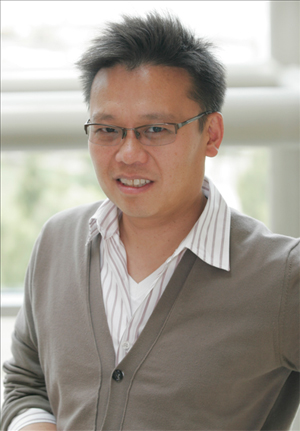There's a reason neuroscientist and bioengineer Karl Deisseroth shows the same video at most of his talks. The movements of the gray mouse with the long tail offer a striking illustration of the power of light to manipulate specific cells.
Barely visible in the overhead view of the mouse is a hair-thin optical fiber that feeds through the animal's skull into the right motor cortex of its brain. As the mouse casually sniffs around and explores its white basin, a cool blue glow appears at the fiber's point of entry. At that instant, the mouse starts circling leftward around the basin, swiftly and deliberately, as though it just received marching orders. A few moments later in the video, the blue glow disappears. The mouse suddenly stops marching and reverts to its lazy meandering, eventually sitting on its haunches.

Deisseroth, an HHMI early career scientist at Stanford University, is part of a growing community of researchers, including several HHMI investigators, who draw upon genomics, genetic engineering, biochemistry, molecular biology, microbiology, biophysics, bioengineering, and optics to tease out the complexities of brain circuitry and to manipulate researcher-specified cells (such as the motor cortex cells of the marching mouse) among thickets of diverse cell types.
Patients with optical fibers inserted into their brains are not on the agenda, says Deisseroth, a psychiatrist who sees patients one day a week. But the laboratory approaches he and others have been developing could reveal telling details about healthy and dysfunctional brains that point the way to improved treatments for people. Today's therapies—drugs, electroshock, surgery—sometimes work. But “they are crude and have side effects,” he says, because they are not very selective about the cells and tissues they affect. “My patients have motivated me to find elegant tools that speak the language of the brain.”
Edward Boyden, a former postdoctoral fellow of Deisseroth who now runs the Synthetic Neurobiology Group at the Massachusetts Institute of Technology, has taken early steps in the direction of human applications. In April 2009, he and colleagues published a paper in Neuron reporting that the same kind of protocol underlying the marching mouse can work, apparently safely, in macaque monkeys. And in 2008, he and two colleagues launched the start-up Eos Neuroscience in San Francisco, whose mission, according to its website, is to “develop treatments for chronic neurological disorders.”
Fixing brains is quite an ambition for a field that commandeered its core technology from single-celled organisms.
 |
WEB EXTRA: Hear Karl Deisseroth talk about where the field of optogenetics is headed. |
Borrowing from Nature
Bacteria, fungi, plants, and other organisms use a repertoire of molecular switches that respond to light. Spanning the membranes of many of these microbial species are light-activated gates and pumps that control the passage of positively charged sodium, potassium, calcium, and hydrogen ions or negatively charged chloride ions.
Those ancient, light-activated membrane gates and pumps can be transferred into other cells of the living kingdom, including mammalian brain and muscle cells, with genetic engineering techniques. Once transferred, those mobile modules become controllable with light. “If you can do that,” says synthetic biologist and HHMI investigator Wendell Lim at the University of California, San Francisco (UCSF), “you have an extraordinarily powerful tool. You can use light to perturb systems and modify them. We can get a kind of systematic control that we have not had before.”
Page 2 of 3
The handiest light-activated molecule so far is channelrhodopsin-2 (ChR2), which was originally found in the light-sensitive “eye spot” of Chlamydomonas reinhardtii, a type of green algae. In Chlamydomonas, upon exposure to blue light, ChR2 opens and allows positively charged ions into the cell. That triggers a sequence of changes that influence the cell's cilia-based propulsion and, thereby, its motion and feeding behavior. When transferred into neurons, ChR2 becomes a light-activated trigger that makes the modified neurons fire more easily. Deisseroth's group used motor neurons that they genetically modified to bear ChR2 receptors to make the mouse march in response to light.
If ChR2 is a blue activator, halorhodopsin (NpHR) is a yellow silencer. It was discovered in Natronobacterium pharaonis, a bacterium isolated from a high-alkaline, high-salt lake in Egypt. In the bacterium, the light-driven NpHR channels pump chloride ions into the cell, a flow that ultimately helps drive the synthesis of ATP, the cell's biochemical fuel. Transferred into neurons, however, these channels respond to yellow light by hyperpolarizing the cells, effectively silencing them.

ChR2 and NpHR make for a powerful duo. They enable researchers to rig neurons and other cell types, including muscle cells and perhaps even insulin-making pancreas cells and immune system cells (see Web Extra, “No Neuron Left Unturned,”), with light-controlled on and off switches. From a third light-activated gate, VChR1, Deisseroth's group developed a tool that responds to light on the red side of the spectrum. VChR1, a channelrhodopsin in Volvox algae, is a cell excitor like ChR2.
For neuroscientists like HHMI investigator Massimo Scanziani of the University of California, San Diego, the real experimental power of these switches becomes clear when they are inserted into specific types of neurons.
To achieve this, Scanziani appends the gene for, say, ChR2 or NpHR, to stretches of DNA known as “cell selective promoters,” each of which becomes operative in only one neuron type. So, even though the gene-insertion step might occur in all neuron types, only one of those types will actually express the ChR2 or NpHR switches.
“This gives you immense sensitivity,” says Scanziani, who uses the technique to probe the function of specific cells in the cortex of animal brains, the region associated with sensation and thought. In mice and rats, for example, Scanziani studies how sensory inputs, such as the contrast between different elements of a visual scene, are processed by neuronal circuitry in the visual cortex. “You now can manipulate a circuit and understand what the heck it does in the brain,” Scanziani says.
The repertoire of light-switchable modules available for optogenetics studies is growing. “There's a Home Depot of different kinds of switches out there,” says Michael Ehlers, an HHMI investigator at Duke University Medical Center, where he studies the structure and dynamics of the synapses through which neurons communicate with one another. Deisseroth's group, for one, continues to stock the shelves with more and more optogenetic switches.
|
WEB EXTRA: Practitioners in the nascent field of optogenetics are getting the hang of genetically modifying cells to make them responsive to and controllable by light. |
Their newest category of switches, the optoXRs, enable researchers to modify cells to respond to light as though they were being stimulated by neurotransmitters, such as adrenaline and dopamine. These switches combine a light-sensing rhodopsin component with the internal parts of a G protein-coupled receptor. That's a large family of receptors that trigger internal cellular responses to sensory, hormonal, neurochemical, and other stimuli arriving at the outside of the cell. For neuroscientists, optoXRs open entirely new research approaches for studying Parkinson's disease, schizophrenia, addiction, and other severe neurological problems, Deisseroth says.
Page 3 of 3
Boyden and his colleagues are trolling the ever-enlarging library of genomic databases to diversify the optogenetic tool set. That's how he and his coworkers found Arch and Mac, two light-driven proton pumps (the first from a bacterium, the second from a fungus) that silence cells into which the researchers insert them when the switches are exposed to yellow and blue light, respectively. The scientists reported their initial work with them in a Nature paper on January 7, 2010.
Cell Sculpting
Lim, at UCSF, is applying optogenetic methods to illuminate the localized, protein-protein interactions that underlie everything from turning genes on and off, to making cells more or less sensitive to stimuli, to cytoskeletal remodeling that alters a cell's shape or influences its movements.

Phytochrome B is a light-sensitive receptor in the mustard plant Arabidopsis thaliana that Lim is developing as a versatile molecular tool. In its normal role, the phytochrome enables the plants to respond to shade. When bathed in red light, for example, the phytochrome undergoes a shape change that leads to the alteration of gene expression in ways that cause the plant to grow toward sunnier patches of space.
In one audacious show of experimental control, Lim and his colleagues combine the phytochrome with an enzymatic component into modules so they can use light to trigger the polymerization of actin protein molecules in a cell. This results in localized changes in the cell's cytoskeletal framework, which determines the cell's shape. Using precision optics, the researchers can induce localized shape changes with enough finesse that Lim refers to the process as cell sculpting.
Lim can imagine using light to orchestrate new organizations of cells, perhaps even for making neuron-based logic components for biological computers or to help reconstruct damaged nerve tissue.
To demonstrate the utility of the approach in fine cell sculpting, Lim's group used a digital micromirror array device to project a minuscule “game of life” movie onto mammalian cells containing the phytochrome module. Each movie frame displays a pattern of dark and light boxes. The pattern evolves in a systematic way from frame to frame—dark boxes become light and vice versa, according to simple mathematical rules. By projecting these changing patterns of light and dark boxes (pixels) onto a cell, the researchers induced the cell surface to embody the same morphing patterns.
|
WEB EXTRA: What comes after the first generation of optogenetics tools? |
In a paper in the September 13, 2009, issue of Nature, Lim and several UCSF colleagues at the Cell Propulsion Lab say they should be able to link the phytochrome light switch to many other cell signaling pathways that involve the recruitment of protein players. Lim refers to the system as a “universal remote control” for experimentally dictating when and where in a cell to activate a pathway of interest. He can also imagine expanding the toolkit.
“We are learning how to dissect biological systems the way electronics engineers dissect circuits,” Lim says. Elegant, precise interventions in neural circuitry, the kind that optogenetics researchers are exploring, stand a chance of eventually taking the place of blunt instruments like surgery, electrodes, and the present generation of pharmaceuticals.
- 1
- 2
- 3











